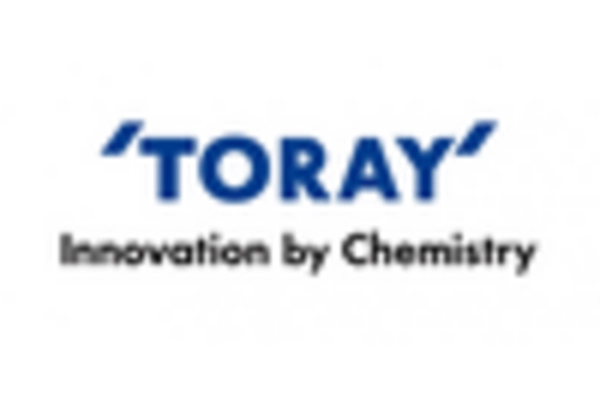Rising Demand for Lightweight Materials
The advanced material market is experiencing a notable surge in demand for lightweight materials, particularly in the aerospace and automotive sectors. This trend is driven by the need for improved fuel efficiency and reduced emissions. In the GCC, the aviation industry is projected to grow at a CAGR of 4.5% from 2025 to 2030, necessitating the use of advanced composites and alloys. Furthermore, lightweight materials contribute to enhanced performance and safety, making them increasingly attractive to manufacturers. As companies strive to meet stringent regulatory standards, the adoption of these materials is likely to accelerate, thereby propelling the advanced material market forward. The shift towards lightweight solutions not only aligns with environmental goals but also enhances the competitive edge of manufacturers in the region.
Government Support and Policy Frameworks
Government initiatives in the GCC are playing a pivotal role in shaping the advanced material market. Policies aimed at diversifying economies and reducing reliance on oil are fostering innovation in material science. For instance, the UAE's Vision 2021 emphasizes the development of advanced technologies, which includes materials research. Financial incentives and grants for R&D projects are becoming more prevalent, encouraging companies to invest in advanced materials. This supportive environment is expected to stimulate growth, with the market projected to reach $5 billion by 2027. The alignment of government policies with industry needs is likely to create a robust ecosystem for the advanced material market, facilitating collaboration between public and private sectors.
Increased Focus on Renewable Energy Solutions
The advanced material market is witnessing a significant shift towards renewable energy applications, particularly in solar and wind energy sectors. The GCC region is investing heavily in renewable energy projects, with a target of generating 50% of its energy from clean sources by 2050. This transition necessitates the development of advanced materials that can withstand harsh environmental conditions while maintaining efficiency. For example, the use of advanced polymers and composites in solar panels is becoming more common, enhancing durability and performance. As the region moves towards sustainability, the advanced material market is likely to benefit from increased demand for innovative solutions that support renewable energy initiatives.
Growing Applications in the Construction Sector
The advanced material market is experiencing growth due to its expanding applications in the construction sector. With the GCC undergoing rapid urbanization and infrastructure development, there is a rising demand for materials that offer enhanced durability and sustainability. Advanced composites and smart materials are increasingly being utilized in construction projects to improve energy efficiency and reduce maintenance costs. For example, the use of self-healing concrete and energy-efficient insulation materials is gaining traction. The construction industry in the GCC is projected to grow by 7% annually, further driving the demand for advanced materials. This trend indicates a shift towards innovative building solutions that align with modern architectural practices.
Technological Integration in Manufacturing Processes
The integration of advanced technologies such as artificial intelligence and automation in manufacturing processes is transforming the advanced material market. In the GCC, industries are increasingly adopting smart manufacturing techniques to enhance efficiency and reduce costs. This technological shift allows for the production of complex materials with superior properties, catering to diverse applications. For instance, 3D printing technologies are enabling the creation of customized advanced materials, which is particularly beneficial in sectors like healthcare and aerospace. As manufacturers embrace these innovations, the advanced material market is expected to expand, with a projected growth rate of 6% annually over the next five years. The synergy between technology and material science is likely to redefine industry standards.

















Leave a Comment